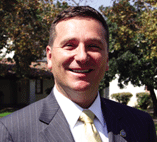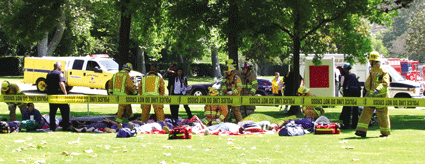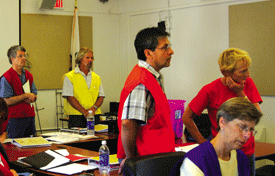The recent fifth anniversary of the 9/11 terrorist attacks have once again heightened the awareness for due diligence in establishing security and safety measures -- including policies that make sense on our campuses....
By John Reid

In the aftermath of September 11th, every sector of society, and particularly law enforcement, was called upon to reexamine the nation's defenses and vulnerabilities in light of new realities. There was little doubt that change was required in many areas. Public safety operations on college and university campuses are no exception.
But securing the California State University, the largest and most diverse university system in the country, is a complex task. Debate will continually center on tightening access to information, facilities, and materials versus maintaining an open campus environment. The debate over the need to address risk and vulnerability creates new problem-solving challenges for public safety officials.
The California State University, not unlike other institutions of higher education, is an open environment in which students, faculty, and others move about freely with few security restrictions. Freedom of movement is encouraged. Restrictions are seen as contrary to the core mission, which generally embodies an environment of intellectual and physical openness. Most people who live and work on individual campuses assume that they are safe and give little thought to risk.
Public safety officials, however, do not assume everything is safe and give a great deal of thought to risk.
Institutions of higher education, including the California State University, are potentially vulnerable to foreign or domestic terrorist acts. What can we do as partners to ensure our University is safe and secure, while at the same time maintaining the open and accessible environment so vital to our purpose? I recommend the following:
- Create a campus-wide safety and security collective, for the purpose of supporting a comprehensive agenda based upon cooperation and collaboration. Individuals as well as the system should collectively meet for regular and comprehensive "summits" on public/campus safety issues. Security and safety objectives should be included in every program's strategic plan.
- Operate a safe campus through prevention and response. Conduct assessments to ensure that comprehensive security and prevention measures are in place and supported.
- Strengthen the necessary operations and administrative functions. Each time a programmatic change is made we need to ask, "How does this impact or change what we need to be doing in the area of public safety?"
- Educate the University community about the importance of immediately reporting to campus police officials any of the following activities:
- Unusual interest and/or questions by non-affiliated persons about security or facility measures.
- Interest in obtaining site plans, bus routes,attendance lists, and other information about the institution.
- An increase in anonymous telephone or e-mail threats or inquiries.
- Surveillance, photographing, sketching of University facilities or areas by unknown persons.
- Unexplained persons in places where they should not be.
These points should be discussed on all campuses, involving all constituents. From dialogue must come a policy that integrates actions and reactions, defines responsibilities, and provides comprehensive measures. Cooperation and vigilance go hand-in-hand.
Security is the highest priority of any campus community. I look forward to working with my colleagues at CSUCI and at other CSU campuses to ensure a safe environment for our students.

Successful Disaster Drill Highlights University's Emergency Plan Efforts
 Picture this scenario: A controversial figure is giving a speech at The Hub, when suddenly an explosion occurs, seriously injuring dozens of people. Through the smoke, victims lie helpless, many of them bleeding.
Picture this scenario: A controversial figure is giving a speech at The Hub, when suddenly an explosion occurs, seriously injuring dozens of people. Through the smoke, victims lie helpless, many of them bleeding.
The scene could easily develop into chaos--but doesn't. Swinging into action in a coordinated effort to respond to the incident are the University's Emergency Operations Center (EOC) team as well as area law enforcement and fire officials.
What happened in this simulated disaster drill held last summer was a valuable practice session to integrate and coordinate emergency activities. "The drill was made possible by a Homeland Security grant," said Jeff Cowgill, administrative sergeant, Public Safety patrol operations. "The purpose was to test University operations, local police, and fire departments. We had fire engines, an ambulance, even a helicopter. More than 100 volunteers participated, many of them wearing lifelike blood makeup and acting as victims."
On scene to assess the efficiency and effectiveness of emergency operations were independent evaluators, including officials from Homeland Security, CSU, and the Los Angeles and Ventura Counties.
Prior to the event, the University's EOC team members from across the campus met frequently to conduct simulations and practice sessions as a prelude to the actual disaster drill.
"The drill verified our emergency operations training," Cowgill said. "These were valuable lessons in the field. We're very pleased. We're very happy with the unity of command. We learned a lot."
John Reid Information
CSUCI's new director of public safety, John Reid, brings to the University extensive experience, both as a campus law enforcement officer and as an expert in security in the broader, global sense. Reid, who has a master of science degree in criminal justice from the University of Cincinnati and is a graduate of the 202nd session of the FBI National Academy in Quantico Virginia, was formerly chief of police at the University of Wisconsin -- Whitewater, and before that a police captain at the University of Arkansas. He is actively involved as a member the International Association of Campus Law Enforcement Administrators and the International Association Chiefs of Police. In this article, Reid offers insights into the security issues affecting campuses today.
